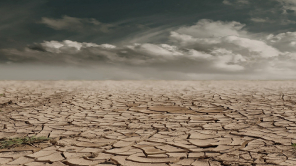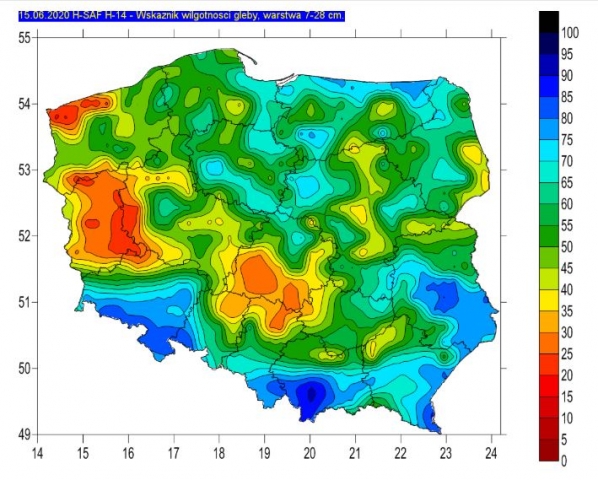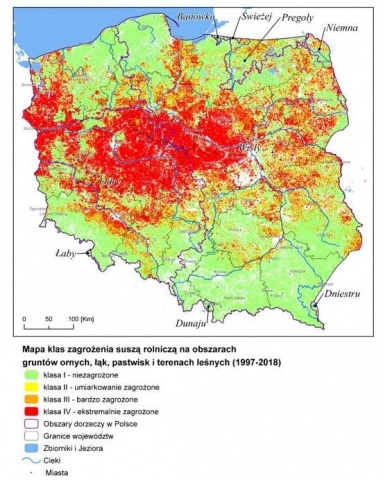Today, on 17 June, we celebrate the World Day to Combat Desertification and Drought. The purpose of this day is to draw attention to ways we can prevent these phenomena. Although recently in Poland the hydrological conditions have improved, this situation may change as the rainfall has not replenished the water deficiency in the environment caused by last year’s drought. Currently, soil moisture has clearly increased in Kujawy, Podlasie and the Lublin Region, whereas the situation in parts of the West Pomeranian, Lubuskie and Łódź Provinces is still difficult. Therefore, counteracting the effects of drought, including the collection of rainwater, is essential in Poland every day of the year.
The map of soil moisture at a depth of 7-28 cm locally still indicates water deficiency. Source: www.stopsuszy.imgw.pl
The observed climate changes have intensified the frequency of occurrence of extreme phenomena, including droughts. Over the past few years, problems connected with drought effects have been experienced by almost all of us. One of the purposes of the Stop Drought! project is just to counteract this trend. The most important part has been developing the drought effects counteracting plan (DECP). Drought effect counteracting is one of the priority activities undertaken by the National Water Management Authority as Poland is a European Union member state with some of the scarcest water resources.
Europe, but also Wielkopolska, Pomerania and Kujawy
When we think about drought or desertification, African countries often come to mind in first place. However, our part of the world is also experiencing these adverse climatic events. This primarily concerns all countries on the northern side of the Mediterranean and on the Black Sea, and one of its effects is a gradual steppe formation. Although there is a long way between this phenomena and desertification, it has been used since the 1930s to determine the processes leading to it. In Poland, mainly Wielkopolska and Kujawy are commonly deemed to be areas prone to the occurrence of draught. However, the assessment of droughts from 1987-2018 indicates that these areas are not the only ones where the severe effects of droughts are experienced. According to the analyses, as much as 55.64% of Poland has a high degree of drought risk. Areas with the highest, extreme levels of risk cover nearly 5% of the country. Areas assessed as being highly endangered by drought include parts of Western Pomerania, Wielkopolska, Kujawy, the Silesian Lowland, the Małopolska Upland, the Lublin Upland, the Łódź Upland, Mazovia, Polesie and Podlasie.
Map of agricultural drought hazard classes from the period: 1997-2018. Source: drought effects counteracting plan (DECP)
Does Poland experience desertification?
Experts warn that although Poland is still far from experiencing the development of real desert areas, the situation is serious and the above regions may be subject to steppe-formation. Climate changes, particularly changes in rainfall patterns, contribute to this phenomena. Currently we are increasingly often observing torrential rains where, during a single day, the sum of the precipitation is equal to that of the monthly norm. Between them, usually in summer, there is a longer period without rainfall. The alternating periods of increased precipitation mean that water resources in Poland do not recover sufficiently. Therefore, it is necessary to collect rainwater at the places where it falls. This can be achieved by small, large and micro retention, including the construction of water reservoirs of different sizes, wetland restoration, afforestation and planting moisture-retaining greenery in cities and on uncultivated land, or sowing flower meadows. More information is available in our publications:
https://www.wody.gov.pl/aktualnosci/1071-retencja-korytowa-nasze-dzialania-w-regionach
As mentioned earlier, the agricultural drought in Poland has decreased due to the fact that May was relatively cool and wet, but the situation may change. Investments related to trough retention, implemented locally with the contribution of Polish Waters, have proved to be very helpful. As farmers stress, by local water damming in rivers and canals, the effects of drought have decreased and increases in crop yields by 30% and even 40% are expected.
Nevertheless, further increases in retention in Poland is necessary as currently we retain approx. 6.5% of rainwater, whereas we should retain at least twice as much. Therefore, the increase in social awareness about low water resources in Poland and the necessity to retain water are key issues nowadays. Campaigns carried out by Polish Waters are devoted to these topics. In the fight against drought effects, it is essential to engage as many entities as possible in education activities, including local-government officials, organisations, associations, local communities, adults, children and youths, as the issue of protecting water resources and the necessity to retain them concerns us all. More information about the Polish Waters’ information and education campaigns is available at:
https://www.wody.gov.pl/aktualnosci/988-razem-powiedzmy-stop-suszy-nasza-nowa-kampania
https://stopsuszy.pl/susza-powodz-retencja/
The World Day to Combat Desertification and Drought was established by the General Assembly of the UN on 30 January 1995. It is celebrated on 17 June. Its main purpose is to organise help for countries experiencing desertification.





